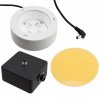Doer
Well-Known Member
Hmmmm.....I've been looking at this. And there are some pretty amazing claims. 80% Eff.?
http://www.intematix.com/uploads/datasheets/ChromaLitPCDatasheet.pdf
I'm still looking for more details but the prices are LOW and efficiency is HIGH. What is the catch, I wonder?
Manufacturer Part Number
CL-830-LR-PC
Digi-Key Part Number1079-1005-ND
Price BreakUnit PriceExtended Price
1 = $10.29
10 = $8.72
TypeRemote Phosphor Light Source
Lens Style/SizeRound with Flat Top, 61.5mm
CRI (Color Rendering Index)80
CCT (K)3000
Conversion Efficacy (lm/Wrad)(typ)200
Viewing Angle115°
Online CatalogChromaLit™ Round and Square
http://www.intematix.com/uploads/datasheets/ChromaLitPCDatasheet.pdf
I'm still looking for more details but the prices are LOW and efficiency is HIGH. What is the catch, I wonder?
Manufacturer Part Number
CL-830-LR-PC
Digi-Key Part Number1079-1005-ND
Price BreakUnit PriceExtended Price
1 = $10.29
10 = $8.72
TypeRemote Phosphor Light Source
Lens Style/SizeRound with Flat Top, 61.5mm
CRI (Color Rendering Index)80
CCT (K)3000
Conversion Efficacy (lm/Wrad)(typ)200
Viewing Angle115°
Online CatalogChromaLit™ Round and Square
Last edited:



